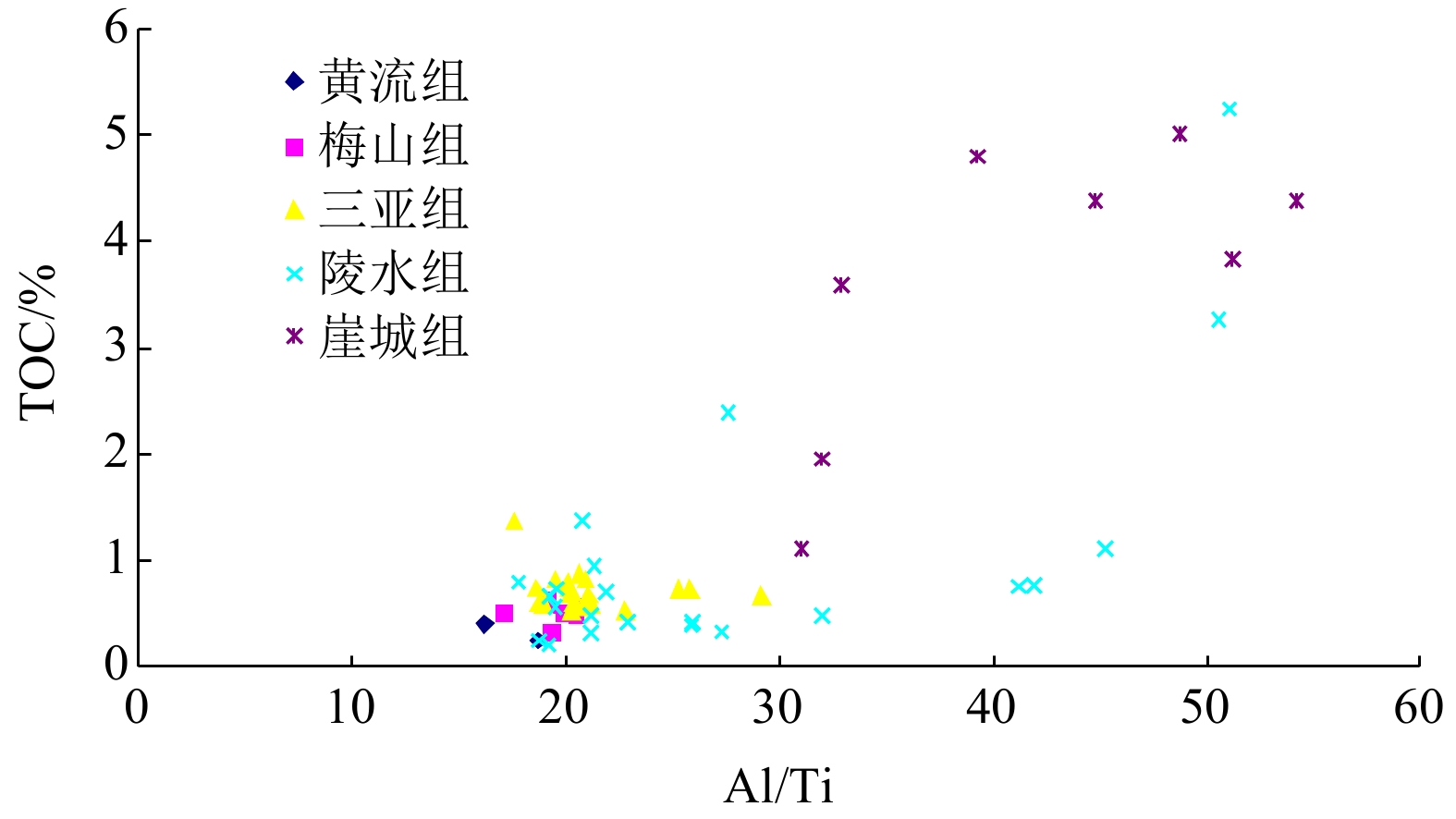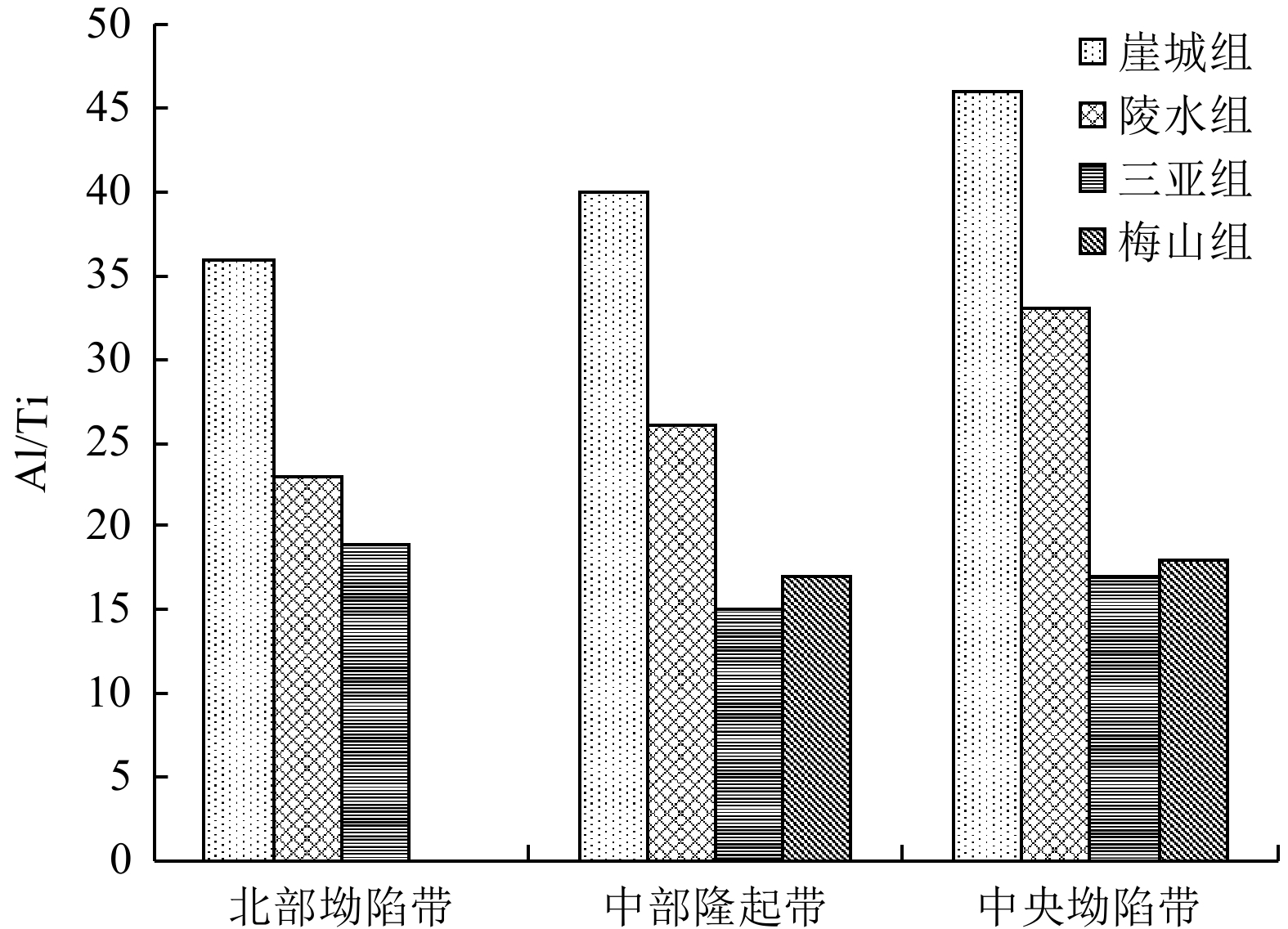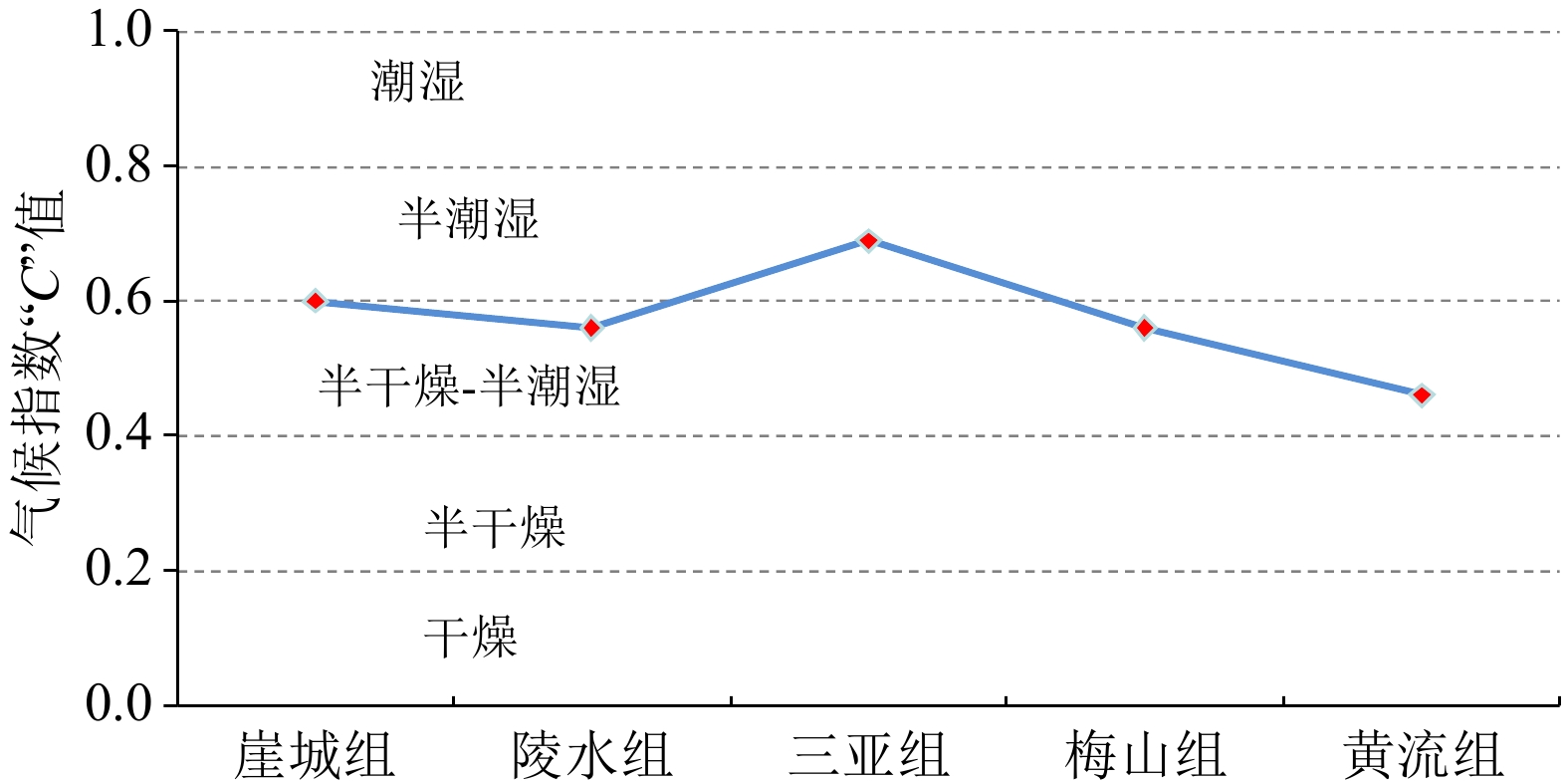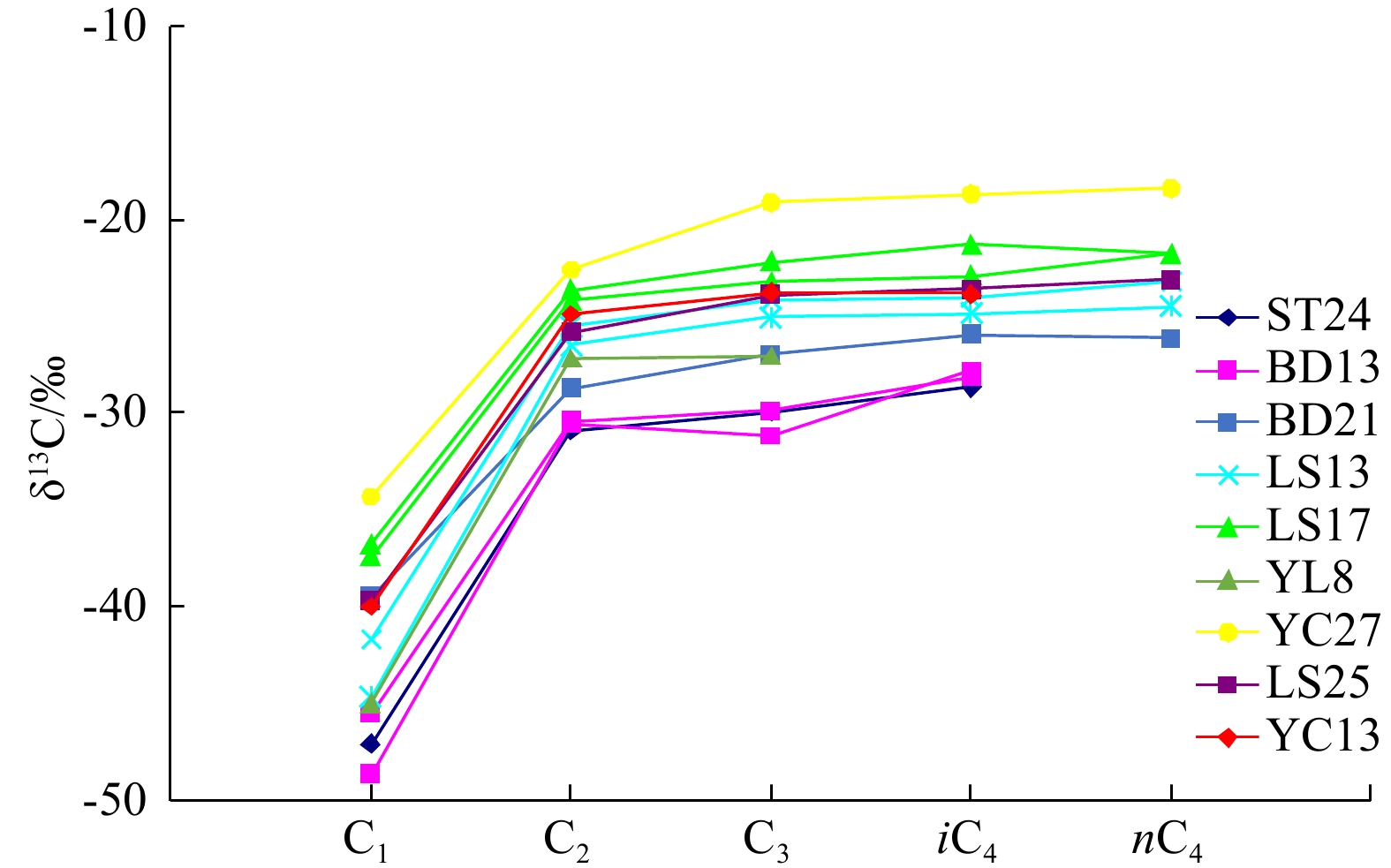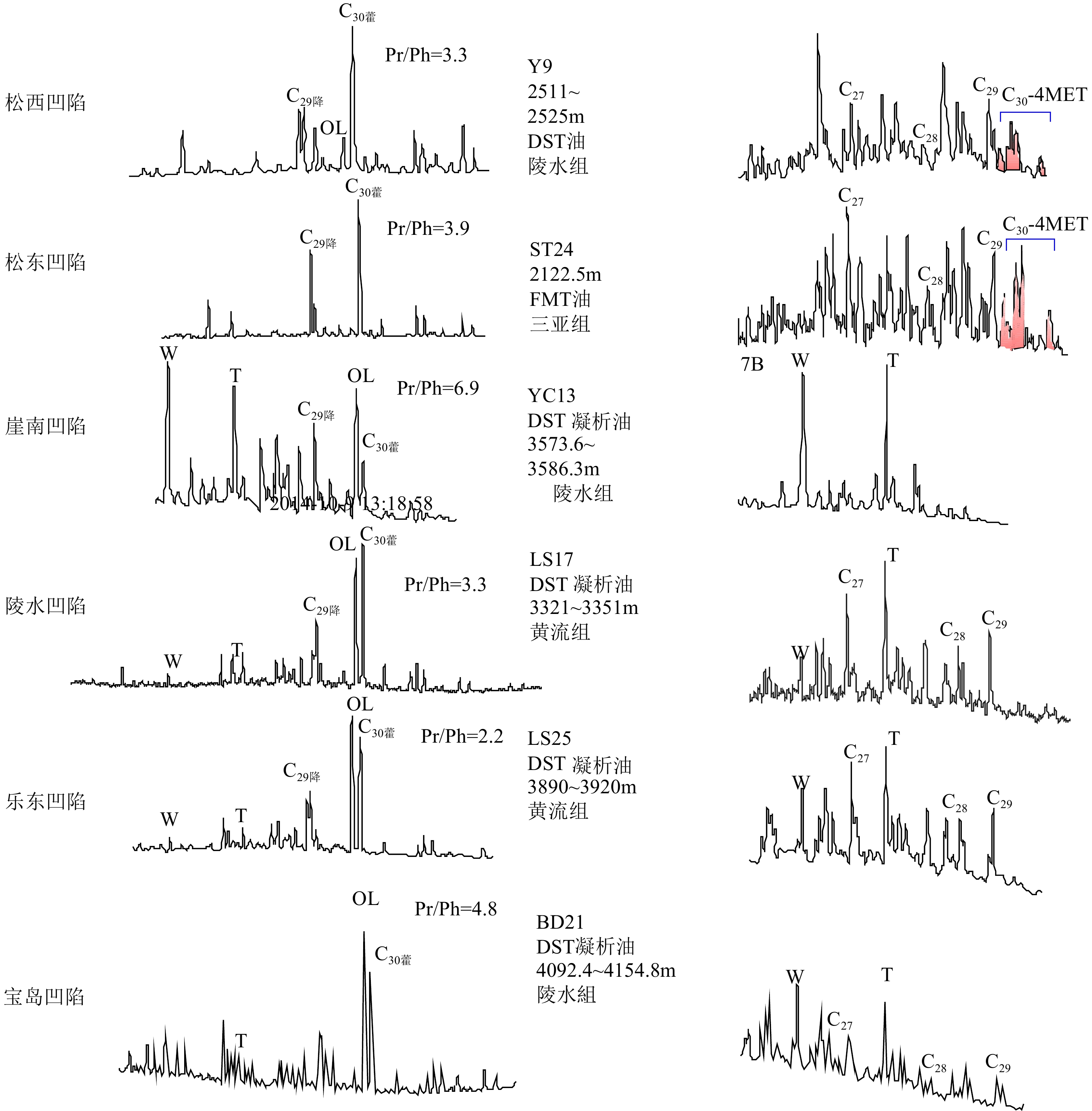Developmental characteristics of source rock and gas source analysis in Qiongdongnan Basin, Northern South China Sea
-
摘要:
琼东南盆地是一个具有巨厚古近系和新近系沉积的新生代沉积盆地,烃源岩主要发育于始新世、渐新世、中新世3个时期。渐新统煤系烃源岩具有广覆式分布的特点,有机质丰度最高,是盆地主力烃源岩;中新统浅海—半深海相烃源岩在深水区中央坳陷厚度大且分布稳定,生烃转化率较高,但有机质丰度较渐新统偏低,是盆地潜在烃源岩;始新统湖相地层虽然探井尚未钻遇,但地震相特征及烃源对比表明,盆地大部分地区均存在始新统中深湖相烃源岩。应用元素地球化学方法分别对盆地不同区带不同时期生物发育的古生产力、古气候及水动力特征等进行了分析研究,初步证实中央坳陷古生产力最高,其次为中部隆起区,北部坳陷则相对较低。基于以上研究,提出了琼东南盆地烃源岩主要发育于3个时期,有4种类型:始新统中深湖相烃源岩、早渐新统崖城组海陆过渡相煤系烃源岩、中—晚渐新统崖城-陵水组半封闭浅海相陆源烃源岩及中新统浅海-半深海相陆源潜在烃源岩。在此基础上,根据大量油气勘探成果及油气地球化学特征,综合判识认为盆地中央坳陷带是渐新统烃源岩最有利发育区且生烃潜力大,其次为北部坳陷带和中部隆起区。气源综合判识表明,中央坳陷带目前勘探发现的深水气田群气源供给主要来自渐新统崖城组煤系烃源岩及半封闭浅海相陆源烃源岩,而北部坳陷带广大区域油气来源则可能主要来自始新统湖相烃源岩。
Abstract:The Cenozoic Qingdongnan Basin hosts a very thick Tertiary strata including three sets of source rocks from bottom to top: the Eocene, the Oligocene (containing Lingshui-Yacheng Formation), and the Miocene. The Oligocene is the key source rock with high abundance of organic matter widespread in basin and coal-bearing strata developed locally. The Miocene is thick neritic-bathyal facies that distributed stably in the central depression zone with high hydrocarbon conversion rate and is potential type of source rock. The Eocene is a set of important hydrocarbon source rocks and has not been drilled through at present. However, seismology study shows that the northern depression belt developed source rocks of semi-deep lacustrine deposits. Study of elemental geochemistry shows that the central depression zone has the highest paleoproductivity; the central uplift belt is in the second place; and the northern depression belt has the lowest paleoproductivity. The paleoclimate of the early Oligocene and early Miocene were warm and favorable to the development of source rocks. Based on the above information, three developmental modes was put forward, i.e., the transitional facies, the semi-enclosed marine facies, and the marine facies. On the basis of modes above, the most advantageous zones that contain high quality source rock is the central depression belt. The northern depression belt and the central uplift belt are in the second place. In addition, geochemistry data, the composition and carbon isotope characteristics of gas indicate that the gas-bearing structure in the northern depression belt is characterized by oil type gas, which may be contributed by the Eocene. The gas fields in the central depression mainly come from the Oligocene Yacheng Formation, featured coal type gas.
-

-
表 1 琼东南盆地第三系烃源岩岩性特征及有机质丰度综合评价
Table 1. Comprehensive evaluation of lithologic characteristics and organic matter abundance of the Tertiary source rocks in Qiongdongnan Basin
层位 岩性 TOC/% 级别 S1+S2/(mg/g) 级别 HC/10-6 级别 总评 黄流组 暗色泥岩 0.22~2.76 中等烃源岩 0.01~2.14 较差烃源岩 40.1~295.4 较差烃源岩 较差—中等烃源岩 0.62(82) 0.53(72) 132.2(60) 梅山组 暗色泥岩 0.22~2.1 中等烃源岩 0.03~3.35 较差烃源岩 55.2~335.6 较差烃源岩 较差—中等烃源岩 0.60(37) 0.63(32) 170.2(30) 三亚组 暗色泥岩 0.21~0.90 较差烃源岩 0.04~5.21 较差烃源岩 78.4~378.2 较差烃源岩 较差烃源岩 0.58(41) 0.62(43) 187.6(24) 陵水组 暗色泥岩 0.22~5.45 中等烃源岩 0.03~11.6 较差烃源岩 60.7~356.6 中等烃源岩 中等—较差烃源岩 0.72(41) 0.84(33) 212(30) 崖城组 暗色泥岩 0.22~4.17 中等烃源岩 0.06~6.78 较差烃源岩 99.5~500.2 中等烃源岩 0.88(60) 0.80(56) 260.2(46) 碳质泥岩 6.69~9.90 好的烃源岩 7.7~23.42 好的烃源岩 好的烃源岩 8.44(7) 16.37(7) 煤 32.27~81.7 好的烃源岩 12.4~154.4 好的烃源岩 52.03(10) 93.31(10) 注:表中数据格式:最小值~最大值/平均值(样品数)。 表 2 琼东南盆地主要气田及含油气构造天然气组成与碳同位素特征
Table 2. Natural gas composition and carbon isotope characteristics of major gas fields and hydrocarbon-bearing structures in Qiongdongnan Basin
区带 井号 地层 取样
方式井深/m 烃类气/% 非烃气
/%干燥
系数碳同位素δ13C/‰ C1 C2—5 N2 CO2 C1/C1—5 C1 C2 C3 iC4 nC4 CO2 松东凹陷 ST24 SY MDT 2 122.2 74.30 9.80 6.77 7.81 0.88 −47.06 −30.92 −29.96 −7.61 宝岛凹陷北坡 BD13A MS DST 1 573~1 580 86.14 10.24 2.46 0.72 0.89 −48.65 −30.53 −31.15 −25.54 BD13B MS MDT 1967.5 82.48 8.09 6.67 1.18 0.91 −45.53 −30.39 −29.84 −29.33 宝岛凹陷北部断阶 BD21A LS DST 4 092.4~4 154 67.14 5.74 0.27 26.55 0.92 −39.46 −28.69 −26.96 −25.89 −26.10 −5.03 BD21B LS MDT 4 268.50 60.38 9.06 2.57 27.71 0.86 −39.83 −29.43 −27.37 −26.24 −26.35 −4.76 陵水低凸起 LS13A MS MDT 3 607.8 69.19 24.24 0.63 4.10 0.74 −41.66 −25.41 −24.17 −24.00 −23.20 −12.61 LS13B MS DST 3 776.9~3 786 79.52 15.76 0.53 3.86 0.83 −44.67 −26.49 −25.02 −24.82 −24.46 −7.88 陵水凹陷 LS17A HL MDT 3 324.0 93.25 5.79 0.62 0.21 0.94 −36.78 −23.62 −22.17 −21.26 −21.75 −17.76 LS17B HL MDT 3 331.3 91.51 6.01 2.15 0.07 0.94 −37.40 −24.16 −23.21 −22.89 −21.75 −18.08 松南低凸起 YL8A YC MDT 2 880.5 95.65 2.81 0.79 0.65 0.97 −44.97 −27.17 −27.04 −12.43 YL8B Pre-Tertiary DST 2 828.8~2 936 95.67 3.30 0.19 0.83 0.97 −43.39 −26.92 −26.76 −2.98 乐东凹陷 YC27 HL MDT 4 390.0 90.6 2.77 1.30 5.24 0.97 −34.31 −22.55 −19.08 −18.66 −18.35 −9.23 LS25 HL MDT 3 760.8 87.89 7.82 1.48 2.20 0.92 −39.69 −25.78 −23.86 −23.56 −23.07 −12.48 崖南凹陷 YC13A LS DST 3 658.8~3 701.9 84.18 3.36 1.04 10.79 0.96 −35.50 YC13B LS DST 3 888.6~3 907.5 86.63 1.81 0.10 11.60 0.98 −35.12 YC13C LS DST 3 898.3~3 921.3 84.58 4.65 1.76 8.73 0.95 −37.09 −26.29 −27.71 −24.78 YC13D LS DST 3 901.4~3 938.0 82.96 7.86 0.26 8.33 0.91 −39.99 −24.88 −23.72 −23.84 -
[1] 何家雄, 张伟, 卢振权, 等. 南海北部大陆边缘主要盆地含油气系统及油气有利勘探方向[J]. 天然气地球科学, 2016, 27(6):943-959 doi: 10.11764/j.issn.1672-1926.2016.06.0943
HE Jiaxiong, ZHANG Wei, LU Zhenquan, et al. Petroleum system and favorable exploration directions of the main marginal basins in the northern South China Sea [J]. Natural Gas Geoscience, 2016, 27(6): 943-959. doi: 10.11764/j.issn.1672-1926.2016.06.0943
[2] 何家雄, 陈胜红, 刘海龄, 等. 南海北部边缘莺-琼盆地油气资源前景及有利勘探方向分析[J]. 天然气地球科学, 2008, 19(4):492-498 doi: 10.11764/j.issn.1672-1926.2008.04.492
HE Jiaxiong, CHEN Shenghong, LIU Hailing, et al. Petroleum resource potential and advantageous exploration targets in Ying-Qiong Basin, northern margin of South China Sea [J]. Natural Gas Geoscience, 2008, 19(4): 492-498. doi: 10.11764/j.issn.1672-1926.2008.04.492
[3] 何家雄, 李福元, 王后金, 等. 南海北部大陆边缘深水盆地成因机制与油气资源效应[J]. 海洋地质前沿, 2020, 36(3):1-11 doi: 10.16028/j.1009-2722.2019.213
HE Jiaxiong, LI Fuyuan, WANG Houjin, et al. Genetic mechanism of deepwater basins and their effects on oil and gas resources on the continental margin of the northern South China Sea [J]. Marine Geology Frontiers, 2020, 36(3): 1-11. doi: 10.16028/j.1009-2722.2019.213
[4] 李绪深, 王振峰, 等. 琼东南盆地深水区烃源岩地球化学特征与天然气潜力[J]. 中国海上油气, 2012, 24(4):1-7
HUANG Baojia, LI Xushen, WANG Zhenfeng, et al. Source rock geochemistry and gas potential in the deep water area, Qiongdongnan basin [J]. China Offshore Oil and Gas, 2012, 24(4): 1-7.
[5] 梁刚, 甘军, 李兴, 等. 琼东南盆地浅水区与深水区烃源岩热演化差异性影响因素研究[J]. 特种油气藏, 2019, 26(1):69-74 doi: 10.3969/j.issn.1006-6535.2019.01.012
LIANG Gang, GAN Jun, LI Xing, et al. Influential factors of thermal evolution difference of source rocks in shallow and deep water areas of southeastern Hainan Basin [J]. Special Oil & Gas Reservoirs, 2019, 26(1): 69-74. doi: 10.3969/j.issn.1006-6535.2019.01.012
[6] 杨计海, 黄保家, 杨金海. 琼东南盆地深水区松南低凸起天然气成藏条件与勘探潜力[J]. 中国海上油气, 2019, 31(2):1-10
YANG Jihai, HUANG Baojia, YANG Jinhai. Gas accumulation conditions and exploration potentials of natural gases in Songnan low uplift, deep water area of Qiongdongnan basin [J]. China Offshore Oil and Gas, 2019, 31(2): 1-10.
[7] 龚再升, 李思田, 谢泰俊, 等. 南海北部大陆边缘盆地分析与油气聚集[M]. 北京: 科学出版社, 1997: 1-510
GONG Zaisheng, LI Sitian, XIE Taijun, et al. Continental Margin Basin Analysis and Hydrocarbon Accumulation of the Northern South China Sea[M]. Beijing: Science Press, 1997: 1-510.
[8] 李绪宣, 钟志洪, 董伟良, 等. 琼东南盆地古近纪裂陷构造特征及其动力学机制[J]. 石油勘探与开发, 2006, 33(6):713-721 doi: 10.3321/j.issn:1000-0747.2006.06.014
LI Xuxuan, ZHONG Zhihong, DONG Weiliang, et al. Paleogene rift structure and its dynamics of Qiongdongnan Basin [J]. Petroleum Exploration and Development, 2006, 33(6): 713-721. doi: 10.3321/j.issn:1000-0747.2006.06.014
[9] 张功成, 杨少坤, 等. 南海北部大陆边缘盆地天然气地质[M]. 北京: 石油工业出版社, 2007: 8-52
ZHU Weilin, ZHANG Gongcheng, YANG Shaokun, et al. Natural Gas Geology of Continental Margin Basins of the Northern South China Sea[M]. Beijing: Petroleum Industry Press, 2007: 8-52.
[10] 黄保家, 王振峰, 梁刚. 琼东南盆地深水区中央峡谷天然气来源及运聚模式[J]. 中国海上油气, 2014, 26(5):8-14
HUANG Baojia, WANG Zhenfeng, LIANG Gang. Natural gas source and migration-accumulation pattern in the central canyon, the deep water area, Qiongdongnan basin [J]. China Offshore Oil and Gas, 2014, 26(5): 8-14.
[11] 梁刚, 甘军, 李兴. 琼东南盆地陵水凹陷天然气成因类型及来源[J]. 中国海上油气, 2015, 27(4):47-53
LIANG Gang, GAN Jun, LI Xing. Genetic types and origin of natural gas in Lingshui sag, Qiongdongnan basin [J]. China Offshore Oil and Gas, 2015, 27(4): 47-53.
[12] 王振峰, 何家雄. 琼东南盆地中新统油气运聚成藏条件及成藏组合分析[J]. 天然气地球科学, 2003, 14(2):107-115 doi: 10.11764/j.issn.1672-1926.2003.02.107
WANG Zhenfeng, HE Jiaxiong. Miocene hydrocarbon’s transferring and collecting condition and reservoir combination analysis in Qiongdongnan Basin [J]. Natural Gas Geoscience, 2003, 14(2): 107-115. doi: 10.11764/j.issn.1672-1926.2003.02.107
[13] 王元, 李贤庆, 王刚, 等. 莺琼盆地中新统海相烃源岩地球化学特征及生烃潜力评价[J]. 现代地质, 2018, 32(3):500-510 doi: 10.19657/j.geoscience.1000-8527.2018.03.08
WANG Yuan, LI Xianqing, WANG Gang, et al. Geochemical characteristics and hydrocarbon generation potential of Miocene marine source rocks in the Ying-Qiong Basin [J]. Geoscience, 2018, 32(3): 500-510. doi: 10.19657/j.geoscience.1000-8527.2018.03.08
[14] 李春荣, 陈开远. 潜江凹陷潜江组元素演化特征及其古气候意义[J]. 石油地质与工程, 2007, 21(6):18-21 doi: 10.3969/j.issn.1673-8217.2007.06.005
LI Chunrong, CHEN Kaiyuan. Evolutional characteristics and their paleoclimate significance of elements in the Qianjiang formation, Qianjiang depression [J]. Petroleum Geology and Engineering, 2007, 21(6): 18-21. doi: 10.3969/j.issn.1673-8217.2007.06.005
[15] Francois R, Honjo S, Manganini S J, et al. Biogenic barium fluxes to the deep sea: implications for paleoproductivity reconstruction [J]. Global Biogeochemical Cycles, 1995, 9(2): 289-303. doi: 10.1029/95GB00021
[16] Dymond J, Suess E, Lyle M. Barium in deep-sea sediment: A geochemical proxy for paleoproductivity [J]. Paleoceanography, 1992, 7(2): 163-181. doi: 10.1029/92PA00181
[17] Murray R W, Leinen M. Scavenged excess aluminum and its relationship to bulk titanium in biogenic sediment from the central equatorial Pacific Ocean [J]. Geochimica et Cosmochimica Acta, 1996, 60(20): 3869-3878. doi: 10.1016/0016-7037(96)00236-0
[18] 韦刚健, 刘颖, 李献华, 等. 南海沉积物中过剩铝问题的探讨[J]. 矿物岩石地球化学通报, 2003, 22(1):23-25 doi: 10.3969/j.issn.1007-2802.2003.01.005
WEI Gangjian, LIU Ying, LI Xianhua, et al. Excess Al in the sediments from South China Sea [J]. Bulletin of Mineralogy, Petrology and Geochemistry, 2003, 22(1): 23-25. doi: 10.3969/j.issn.1007-2802.2003.01.005
[19] 陈亮, 刘春莲, 庄畅, 等. 三水盆地古近系下部湖相沉积的稀土元素地球化学特征及其古气候意义[J]. 沉积学报, 2009, 27(6):1155-1162 doi: 10.14027/j.cnki.cjxb.2009.06.014
CHEN Liang, LIU Chunlian, ZHUANG Chang, et al. Rare earth element records of the lower paleogene sediments in the Sanshui Basin and their paleoclimate implications [J]. Acta Sedimentologica Sinica, 2009, 27(6): 1155-1162. doi: 10.14027/j.cnki.cjxb.2009.06.014
[20] 苗建宇. 新疆北部主要盆地二叠系烃源岩沉积环境与生烃特征[D]. 西北大学博士学位论文, 2001: 65-98
MIAO Jianyu. The depositional environment of Permian system hydrocarbon source rocks and its potential hydrocarbon generating characteristics in major basins in North Xinjiang[D]. Doctor Dissertation of Northwest University, 2001: 65-98.
[21] 刘昭蜀, 赵焕庭, 范时清, 等. 南海地质[M]. 北京: 科学出版社, 2002: 315-400
LIU Zhaoshu, ZHAO Huanting, FAN Shiqing, et al. Geology of the South China Sea[M]. Beijing: Science Press, 2002: 315-400.
[22] 赵一阳, 鄢明才. 中国浅海沉积物地球化学[M]. 北京: 科学出版社, 1994: 15-22
ZHAO Yiyang, YAN Mingcai. Chemistry of Sediments of the China Shelf Sea[M]. Beijing: Science Press, 1994: 15-22.
[23] 王争鸣. 缺氧沉积环境的地球化学标志[J]. 甘肃地质学报, 2003, 12(2):55-58
WANG Zhengming. Geochemical indicators for diagnosing anoxic sedimentary environment [J]. Acta Geologica Gansu, 2003, 12(2): 55-58.
[24] 秦建中, 腾格尔, 付小东. 海相优质烃源层评价与形成条件研究[J]. 石油实验地质, 2009, 31(4):366-372,378 doi: 10.3969/j.issn.1001-6112.2009.04.010
QIN Jianzhong, TENGER, FU Xiaodong. Study of forming condition on marine excellent source rocks and its evaluation [J]. Petroleum Geology & Experiment, 2009, 31(4): 366-372,378. doi: 10.3969/j.issn.1001-6112.2009.04.010
[25] Ashan S A, Karlsen D A, Mitchell A W, et al. Inter and intrafield hydrocarbon compositional variations in the Ula and the Gyda fields (Central Graben-North Sea)-Implication for understanding the controls on hydrocarbon distribution within and between these fields [J]. Organic Geochemistry, 1998, 29(1-3): 429-448. doi: 10.1016/S0146-6380(98)00053-9
[26] 张迎朝, 甘军, 徐新德, 等. 琼东南盆地深水东区Y8-1含气构造天然气来源及侧向运聚模式[J]. 地球科学, 2019, 44(8):2609-2618
ZHANG Yingzhao, GAN Jun, XU Xinde, et al. The source and natural gas lateral migration accumulation model of Y8-1 gas bearing structure, east deep water in the Qiongdongnan Basin [J]. Earth Science, 2019, 44(8): 2609-2618.
[27] 戴金星, 邹才能, 李伟, 等. 中国大气田及其气源[M]. 北京: 石油工业出版社, 2014: 50-62
DAI Jinxing, ZOU Caineng, LI Wei, et al. Giant Coal-Derived Gasfields and Their Gas Sources in China[M]. Beijing: Science Press, 2014: 416-420.
[28] 梁刚, 甘军, 游君君, 等. 琼东南盆地低熟煤型气地球化学特征及勘探前景[J]. 天然气地球科学, 2020, 31(7):895-903
LIANG Gang, GAN Jun, YOU Junjun, et al. Geochemical characteristics and exploration prospect of low mature coal-derived gas in Qiongdongnan Basin [J]. Natural Gas Geoscience, 2020, 31(7): 895-903.
[29] 何家雄, 马文宏, 祝有海, 等. 南海北部边缘盆地天然气成因类型及成藏时间综合判识与确定[J]. 中国地质, 2011, 38(1):145-160 doi: 10.3969/j.issn.1000-3657.2011.01.016
HE Jiaxiong, MA Wenhong, ZHU Youhai, et al. Integrated identification and determination of genetic types and accumulation time in the marginal basin of northern South China Sea [J]. Geology in China, 2011, 38(1): 145-160. doi: 10.3969/j.issn.1000-3657.2011.01.016
[30] 何家雄, 姚永坚, 刘海龄, 等. 南海北部边缘盆地天然气成因类型及气源构成特点[J]. 中国地质, 2008, 35(5):1007-1016 doi: 10.3969/j.issn.1000-3657.2008.05.020
HE Jiaxiong, YAO Yongjian, LIU Hailing, et al. Genetic types of natural gas and characteristic of the gas source composition in marginal basins of the northern South China Sea [J]. Geology in China, 2008, 35(5): 1007-1016. doi: 10.3969/j.issn.1000-3657.2008.05.020
[31] 何家雄, 马文宏, 祝有海, 等. 南海北部边缘盆地天然气成因类型及运聚规律与勘探新领域[J]. 海洋地质前沿, 2011, 27(4):1-10
HE Jiaxiong, MA Wenhong, ZHU Youhai, et al. Genetic types, migration and accumulation of gas in the north marginal basins of South China Sea and new exploration targets [J]. Marine Geology Frontiers, 2011, 27(4): 1-10.
-




 下载:
下载:


